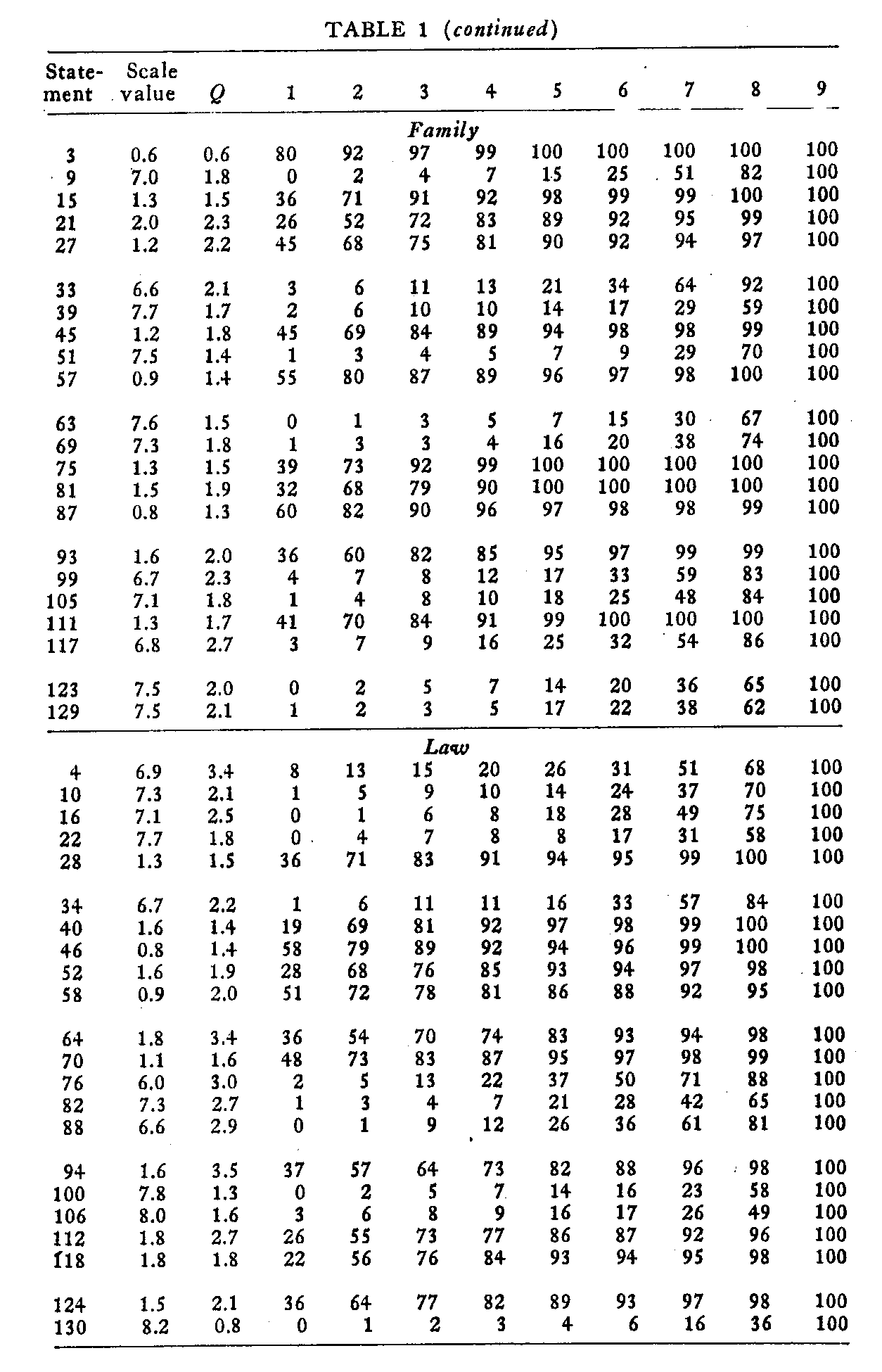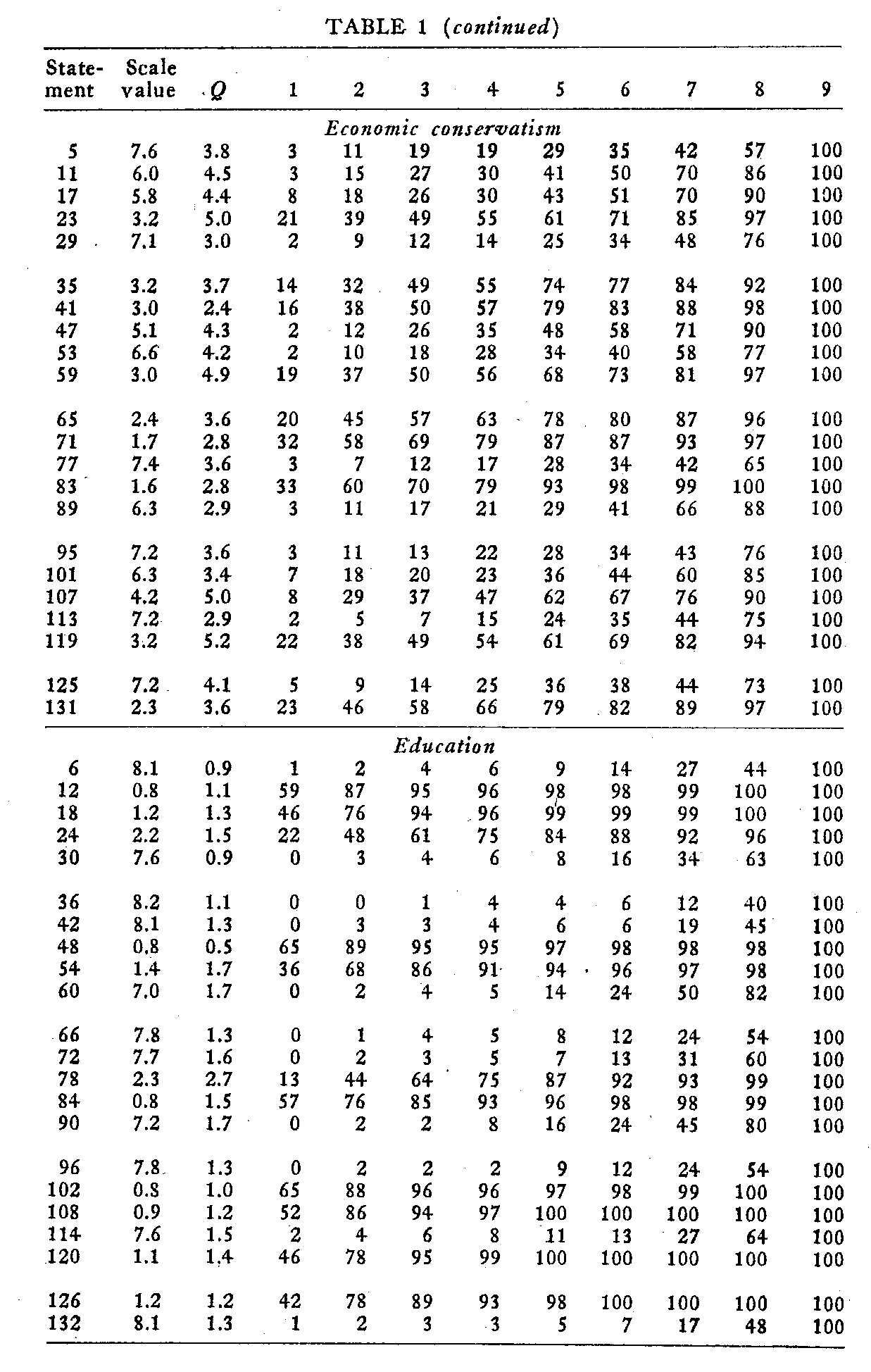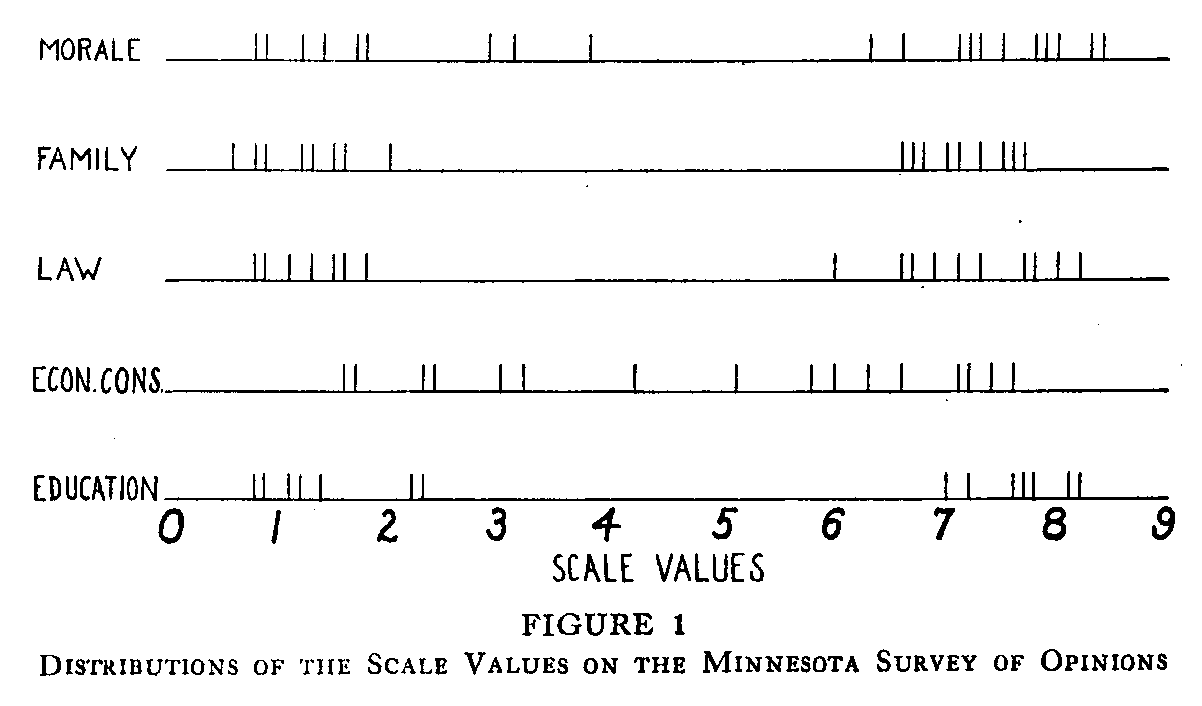A Study of the Likert Technique of Attitude Scale Construction[1]
Leonard W. Ferguson
Department of Psychology, University of Connecticut
The purpose of this article is to make a comparison between the Likert and Thurstone methods of attitude scale construction.
In 1929 Thurstone and Chave (10) presented a method involving the equal appearing interval procedure for scaling items in an attitude scale. As they outlined the method, a rather large number of judges are required to sort statements into piles of equal appearing intervals along the continuum being investigated.[1]
Attempting to shorten this apparently laborious procedure, Likert (4) in 1932 presented a technique which according to him did away with the need for a judging group. His procedure is to extract from the responses of a group of subjects indicating their own attitudes the sigma values to be assigned each response. A simpler method of assigning arbitrary values, 1, 2, 3, 4, 5 to the degrees of agreement and disagreement with each statement has also been suggested. This latter method is the more practical since total scores secured on such a basis correlate +.99 with those secured upon the basis of the sigma scoring technique (4, 5).
The suggestion which is particularly pertinent to this article is that constructing and scoring scales in accordance with Likert's method gives, with much less labor, just as valid results as the more complicated Thurstone procedure. The evidence which Likert gives in support of this contention is presented below. He gave the Droba "War" scale (2) to a group of subjects, requesting them to indicate their agreement or disagreement with each statement by encircling one of these possible responses: strongly approve; approve ; undecided; disapprove; strongly disapprove. He also asked them to indicate their agreement or disagreement with each statement in accordance with the usual Thurstone method. When scared by the "simple" (not the sigma) Likert technique, reliabilities approximated +.88, but when the
( 52) scales were scored by the Thurstone method, reliabilities were nearer +.76 (5). Because of the lesser reliability by the latter method of scoring, Likert concludes that his technique is the better one. This conclusion has been accepted uncritically by Murphy, Murphy, and Newcomb (6), Rundquist and Sletto (7), and possibly by others.
It is well known that, up to a certain limit, increasing the number of steps i n a psychological scale increases reliability (1). Consequently, all that Likert has done in the experiment reported is to verify this point. It should be emphasized, as the writer has pointed out (3), that Likert used a scale which was constructed by the Thurstone equal appearing interval method. Since the statements had been sifted through the sorting procedure, it would seem unjustifiable to conclude that Likert's method did away with the need for a judging group. T o test this point adequately one should compare scales constructed (independently of the Thurstone method) by the Likert technique with those constructed by the equal appearing interval method. Likert reports one such test in that his internationalism scale correlates +.67 with the Droba War Scale (5). Such a correlation hardly warrants the conclusion stated above. Since, however, the content of the two scales is different it may be that they are measures of different things, making it dubious to compare the scales for the purpose of deciding between two methods of scale construction.
A more adequate test can be provided by resealing items using Thurstone's method in scales constructed by Likert's technique. If Likert's technique does away with the need for a judging group, the two methods of treating the statements should give the same result. For this test the writer selected the statements which comprise the Minnesota Scale for the Survey of Opinions (7). This scale, constructed by Rundquist and Sletto by Likert's method, was chosen because of the care with which it was constructed. Considerable attention was paid to the wording of each statement, and all those finally included met a criterion of internal consistency (7, 9).
One hundred subjects were asked to take the Survey. After they had completed it they were given the statements for each of the separate scales of the Survey and were asked to rate, along the appropriate continuum, the degree of attitude that would be represented by agreement with each one. The Seashore-Hevner (8) sorting method rather than the more elaborate Thurstone one was followed. Following the method outlined by Thurstone and Chave (10), scale
( 53) values were computed for all items on the appropriate scales. They, together with the accumulative per cents and Q values, are shown in Table 1.
The standard deviations of the distributions of scale values are 1.6, 1.4, 1.6, 2.9 and 1.2 for the morale, family, law, economic conservatism and education scales respectively.[3] Although the value for the economic conservatism scale is rather high, the rest of them compare favorably with the value 1.25 which Thurstone and Chave report for the standard deviation of the distribution of scale values in their scale for the measurement of attitude toward the church (10, p. 42). A partial answer is thus provided to the question

( 54)

( 55)

( 56) raised by Rundquist and Sletto as to how adequately questions of the type included in the Survey can be scaled by the Thurstone procedure. It would seem evident from the above figures that it is quite possible. Additional effort would certainly result in lowering the values which at present seem too high.
Figure 1 shows the scale values for the statements in each scale.

It is obvious that the statements in most of the scales (economic conservatism excepted) represent only very favorable or very unfavorable attitudes on that continuum. In spite of the care Rundquist and Sletto exercised in the construction of the Survey, little success was achieved in securing statements representing all degrees of attitude along each scale. Since it has been pointed out above that the items in the Survey can be adequately scaled by Thurstone's method, the writer would venture the conclusion that Likert's technique does not do away with the need for a judging group.
It was the writer's intention when he undertook this study to correlate the various series of scores based on the two different methods to determine whether or not they gave comparable results. With the exception of the economic conservatism scale, the results shown in Figure 1 show the impossibility of scoring these scales by the Thurstone procedure. Scales constructed and scored in this manner must have an approximately equal number of statements at all points along the continuum. If, as in the morale scale there are
( 57) seven statements scaled between 7 and 8 but only two between 3 and 4, undue weight is given to the former scale position. If a person agrees with a statement scaled near 7. or 8, theoretically he should agree with all those clustering around that same value; so that if there are not equal numbers of statements at other positions the scale is artificially weighted. Since the scale for economic conservatism has the most adequate distribution of statements along the continuum (but also the highest Q value), the scores as determined by the two methods were correlated with each other and found to be +.70 which amply confirms the conclusion that Likert's technique for the construction of attitude scales does not obviate the need for a judging group.
REFERENCES
1. CONKLIN, E. S. The scale of values method for studies in genetic psychology. Univ.Oregon Pub., 1923, 2, No. 1.
2. DROBA, D. D. Scale for the Measurement of Attitude toward War. Chicago: Univ. Chicago Press, 1929.
3. FERGUSON, L. W. The requirements of an adequate attitude scale. Psychol. Bull., 1939, 36, 665-673.
4. LIKERT, R. A technique for the measurement of attitudes. Arch. of Psychol., 1932, No. 140. Pp. 55.
5. MURPHY, G., & LIKERT, R. Public Opinion and the Individual. New York: Harper, 1938. Pp. viii+ 316.
6. MURPHY, G., MURPHY, L. B., & NEWCOMB, T. M. Experimental Social Psychology. (Rev. Ed.) New York: Harper, 1937.
7. RUNDQUIST, E. A., & SLETTO, R. F. Personality in the Depression. Minneapolis: Univ. Minnesota Press, 1936. Pp. xxii+398.
8. SEASHORE, R. H., & HEVNER, K. A time saving device for the construction of attitude scales. J. Soc. Psychol., 1933, 4, 366-372.
9. SLETTO, R. F. Construction of Personality Scales by the Criterion of Internal Consistency. Minneapolis: Sociol. Press, 1937.
10. THURSTONE, L. L., & CRAVE, E. J. The Measurement of Attitude. Chicago: Univ. Chicago Press, 1929. Pp. xii+96.
Department of Psychology University of Connecticut
Storrs, Connecticut